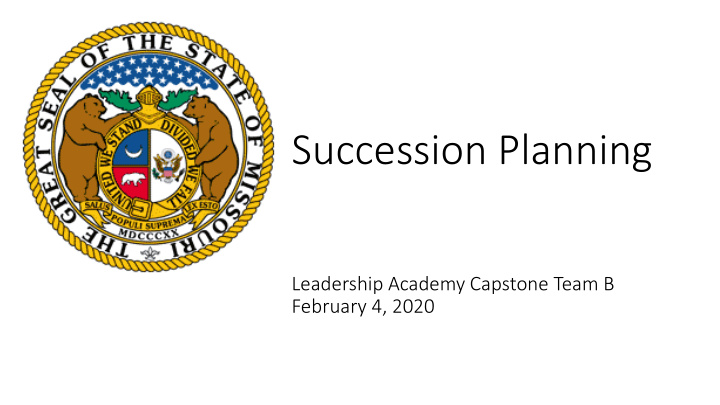



Succession Planning Leadership Academy Capstone Team B February 4, 2020
Succession planning is is critical to the State of Mis issouri Succession planning is the process of identifying critical positions within each agency and developing individuals to assume those positions • Ensures a pipeline of talent to deliver agency strategies and goals Why? • Safeguards against the loss of critical institutional knowledge 2
Succession planning is is often mis isunderstood • A guarantee of promotion or advancement Is NOT • A replacement for the competitive hiring process • Complementary to ENGAGE 2.0 conversations Is • Appropriate at most levels of the organization 3
Every ry department faces a management crisis Institutional knowledge on the verge of retirement: Percent of managers by retirement eligibility year 70% 60% 50% 40% 30% 20% 10% 0% Elig FY20 Elig FY21 Elig FY22 Elig FY23 Elig FY24 Note: Managers supervise other supervisors. Source: OA Personnel, MOSERS, MoDOT, MSHP, MDC 4
Succession planning is is not consistent in in Mis issouri state g government Where does your department fall on this spectrum? None Informal processes Some formal processes Formal processes 5
Succession planning that works: GE example • Senior leaders see talent development as a priority and model behavior consistent with that value • Using a structured process, leaders scan external and internal candidates, identifying a cohort who fit the attributes needed for success of the business • The interview process evaluates all candidates against values and vision of the company 6
Succession planning is is a proven process Identify Measure, Identify Assess Critical Develop Monitor, and Critical Leadership Success Leaders Evaluate Positions Potential Factors Success Positions People Process 7
Step 1 Step 1 – Id Identify fy crit itical positions • Risk assessment approach to identifying positions most in Purpose need of succession planning • Evaluate positions from a risk perspective • Rank positions based on risk assessment Activities • Prioritize positions for succession planning • Executive and/or senior management team Owners • Focus on position, not person Considerations 8
Prioritize positions for succession Step 1 planning using the summary ry form Poor Unique Low Strong Urgent Internal Skill Set or External Impact on Need Knowledge Bench Candidate Business Base Availability Strength 9
Step 2 – Id Identify fy crit itical Step 2 success factors • Identify experiences, competencies, knowledge and skills that have Purpose contributed to success • Assess experiences of successful people • Document key knowledge and responsibilities of incumbent Activities • Determine how best to share key knowledge and responsibilities • Use to strategically plan for the development of potential successors • Supervisors of the position and similar positions for initial assessment Owners • Incumbents of the position for documentation • Focus on position, not person Considerations 10
Step 3 Step 3 – Assess l leadership potential • Develop realistic picture of current state of potential successors Purpose • Identify and assess bench using Nine Box Grid Activities • Identify individuals as “ready now” or “ready later” • Incumbents and supervisors of the position Owners • Review by executive or senior management team • Must be realistic assessment Considerations • Must be specific to position • Informed by ENGAGE 2.0 Growth Model 11
Use the Nine Box Grid id to plot Step 3 potential and performance High Potential Develop Stretch/Develop Stretch/Promote Medium Potential Observe Develop Stretch/Develop Low Potential Observe/Exit Observe Develop Potential ↑ Does Not Meet Meets Exceeds Expectations Expectations Expectations Performance → This tool helps leaders have conversations about the right candidates at the right time. 12
Step 4 Step 4 – Develo lop le leaders • Strategically develop bench/leaders in light of succession needs Purpose • Create development plans including statewide development opportunities and position-specific needs Activities • Implement development plans • Mentor and coach with strategic focus • Individual, supervisor, mentor, other leadership as appropriate Owners • Integrates into ENGAGE 2.0 and Growth Model conversations Considerations • Continuously assess development needs and plans 13
Step 5 – Measure, monitor Step 5 and evalu luate success • Ensure that succession planning happens and is successful Purpose • Quarterly meetings, at a minimum • Monitor implementation of succession planning steps Activities • Establish and monitor metrics for success • Executive and/or senior management team Owners • Executive team needs to take and maintain ownership of process Considerations • Business led and human resources enabled 14
We have no tim ime to lo lose! Percent of managers eligible to retire in FY20 60% 50% 40% 30% 20% 10% 0% Note: Managers supervise other supervisors. 15 Source: OA Personnel, MOSERS, MoDOT, MSHP, MDC
Let’s get started! • Kick-off meeting using agenda • Identify a champion for the process • Review playbook and resources on MOLearning Implementation Recommendations • Decide path of implementation • Identify specific levels/divisions (top down) • Identify based on risk assessment 16
Your guide to success! 17
We are here to help Ashley Buechter, MoDOT Mary Corey, DESE Dan Follett, DOR Travis Terry, DOC Jacinda Thudium, OA Katie Thumann, DMH 18
Recommend
More recommend